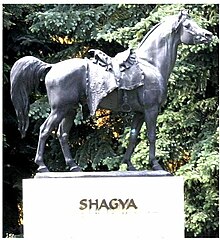Shagya Arabs
| Shagya Arabs | |
|---|---|

Shagya Arabs |
|
| Important data | |
| Origin: | Countries of the Austro- Hungarian monarchy , especially in today's Hungary , Romania and Czechoslovakia |
| Main breeding area: | Hungary, Germany |
| Distribution: | Hungary, Germany, Denmark, Switzerland, Austria, Poland, Bulgaria, Czech Republic, Romania, USA, Venezuela |
| Stick measure : | 150-160 cm |
| Colors : | mostly gray, rarely black horses, foxes and browns |
| Main application area: | Riding horse, sport horse, breeding |
Shagya Arabs is a breed of horse . The Shagya Arabs are largely based on thoroughbred Arabs, an independent breed that has more size, substance and riding horse points than its smaller and more delicate brother, the thoroughbred Arab . This breed was developed since the end of the 18th century in the countries of the Austro- Hungarian monarchy , especially in today's Hungary , Romania and Czechoslovakia . With the exclusive use of thoroughbred Arabian stallions to increase size and caliber, mares from other countries were occasionally and deliberately used, which was recorded in detail in the stud books. The stud book is kept in Germany by the Association of Breeders and Friends of the Arabian Horse VZAP.
Background information on horse evaluation and breeding can be found under: Exterior , interior and horse breeding .
Exterior
The head is small, prominent and dry with a straight to concave forehead line and widely spaced, dark eyes. The gaiters are wide and far apart, the nostrils are large, elastic and expandable. The neck is long and arched upwards, has a slight throat and merges into a sloping shoulder. The withers are pronounced and offer a good saddle position, the back is medium-long with sufficient chest depth. The body is well muscled, the croup long and slightly sloping. The tail is set high and carried raised. The coat and top coat are fine and silky and emphasize the nobility of the breed. The feet and legs are dry, match the body structure and have correct, large joints with medium-length pasterns and well-formed hooves . The dominant coat color is gray, followed by brown, black horses are rare. Foxes are found almost exclusively in the south-eastern European bloodlines, Romania, Serbia, Croatia, Bosnia and Bulgaria.
interior
For its intended use as a ready-to-perform riding and driving horse for all kinds of sporting purposes, the Shagya Arab shows an easy-going and uncomplicated, but at the same time enthusiastic, powerful and nervous character. He shows a balanced and relaxed temperament and makes an intelligent and alert impression. Due to his Arab roots, the Shagya Arab is very philanthropic, if he is treated accordingly.
use
Shagya Arabs used to serve in the army as officer horses, pulled carriages and were sold all over the world for breeding as refiners. Today they are used in various ways in equestrian sports. They are ideal as hiking and endurance riding horses . Their versatile disposition predestines them for the versatile sport , whereby they can show their hardness, their galloping ability and their endurance especially in the cross-country test. But they are also well suited for dressage , jumping and as draft horses in front of light wagons, for hunting with the pack and as leisure horses .
Breeding history

The horse breed was simply called "Arabian breed" until 1978 and was then given its current name, mainly to avoid misunderstandings in the English translation. It was named after the original Arab Shagya, an apple-peeled honey mold, which, however, is not the founder of the breed. Its establishment goes hand in hand with the establishment of the Bábolna Stud at the end of the 18th century. Field Marshal Lieutenant Joseph von Cavallar played a major role in this.
The stallion Shagya, born in 1830, was acquired in 1836 by Baron von Herbert for 1,800 guilders from the Bedouin tribe of the Bani Saher in Syria . He was brought to the Bábolna National Stud in Hungary in 1837 and used there for breeding until he died there in 1842. The stallion had a shoulder height cm of nearly 160th During a visit to the stud in 1839, Prince Hermann von Pückler-Muskau described him as a "powerful, well-muscled, yet very noble stallion".
As a result, Shagya Arabs from the Shagyas tribe were also bred in the state studs of Mezőhegyes , Radautz , Piber and Topoľčianky . In addition to the Shagya tribe, there are other tribes such as Gazal, O'Bajan, Kemir, Siglavy Bagdady, Siglavy and others. a.
See also
literature
Web links
- Information on Shagya Arabs from the International Shagya Arab Society ISG
- Shagya Arab Association of Switzerland SAVS
Individual evidence
- ^ Harvard University: Yearbook of the Bukovinian State Museum . ( archive.org [accessed February 14, 2018]).
- ↑ Erika Schiele: Arabs in Europe . Bayerischer Landwirtschaftsverlag, Munich 1967, DNB 458832510 .


